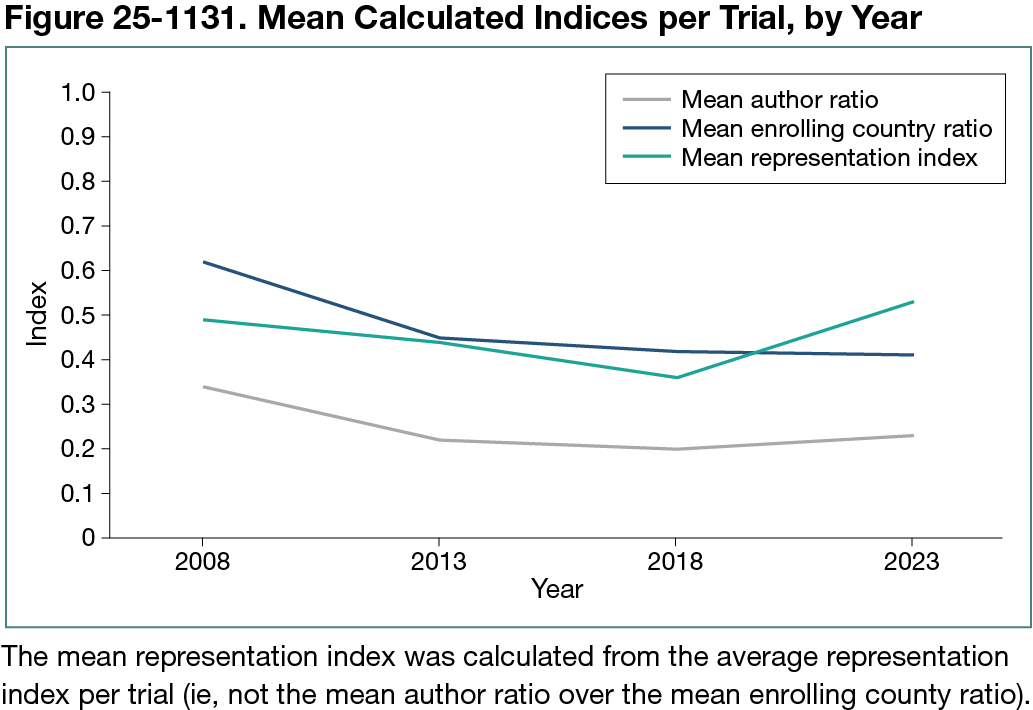Abstract
Representation of Authors From Low- and Middle-Income Countries (LMICs) in Trials With Participants From LMICs
Harleen K. Marwah,1 Abarna Pearl,1 Christos P. Kotanidis,1,2,3 Sarah Gorey,1,4 Darren Taichman,1,5 Mary Beth Hamel1,6
Objective
Trials increasingly include participants from low- and middle-income countries (LMICs),1 but authorship representation may not be proportional. LMIC-affiliated authors on trials recruiting from LMICs offer important perspectives, which have implications for equity, expertise, and capacity building. Prior data have looked at specialty journals or non-Western country categories,2 but author representation specifically in trials with participants from LMICs is not known. This study evaluated trends over time in LMIC-affiliated authorship among trials recruiting participants from LMICs.
Design
Using PubMed, we extracted trials published during alternating months (6 mo/y) in the years 2008, 2013, 2018, and 2023 from 4 high-impact medical journals: the New England Journal of Medicine, The Lancet, JAMA, and BMJ. Four investigators manually identified trials that recruited participants from LMICs, defined by the Wellcome Trust as countries with low-income or middle-income economies.3 We designed and calculated 3 metrics for each trial: (1) an enrolling country ratio (the number of recruiting LMICs divided by the total number of recruiting countries), (2) an author ratio (the number of LMIC-affiliated authors divided by the total number of authors in a trial), and (3) a representation index (RI) (the author ratio divided by the enrolling country ratio). The RI controlled for the proportion of recruiting LMICs in each trial. An RI less than 1 indicated that the proportion of LMIC-affiliated authors was lower than the proportion of recruiting LMICs. An RI of 1 indicated that the 2 ratios were exactly proportionate.
Results
The PubMed search yielded 865 trials, 302 of which recruited participants from LMICs. Of these, 139 (46.0%) were published in the New England Journal of Medicine, 117 (38.7%) in The Lancet, 35 (11.6%) in JAMA, and 11 (3.6%) in BMJ. The number and proportion of trials recruiting participants from LMICs increased between 2008 (52/174, 29.9%) and 2023 (117/262, 44.7%). The mean enrolling country ratio decreased over time, from 0.62 in 2008 to 0.41 in 2023 (Figure 25-1131, blue line). The mean author ratio decreased after 2008 and then remained similar; in 2008, it was 0.34 and in 2023, it was 0.23 (Figure 25-1131, gray line). Between 2008 and 2023, the RI increased modestly from 0.49 to 0.53 (Figure 25-1131, teal line).
Conclusions
This study highlights that LMIC-affiliated authorship in LMIC-recruiting trials has increased modestly over time but remains disproportionate to LMIC participant recruitment sites. Limitations of the study include the lack of information on the proportion of LMIC-recruited participants for each trial. This information could be a stronger indicator as to what LMIC-affiliated authorship representation should look like. Also, LMIC definitions may change over time and by defining organization. While there has been modest improvement in author representation, increased attention may help promote representative and ethical research.
References
1. Number of clinical trials by year, country, WHO region and income group (1999-2024). World Health Organization. December 2024. Accessed April 15, 2025. https://www.who.int/observatories/global-observatory-on-health-research-and-development/monitoring/number-of-clinical-trials-by-year-country-who-region-and-income-group
2. De Oliveira-Gomes D, Guilliod C, Gebran K, et al. Equity and representation in cardiology research: a comprehensive analysis of authorship from low and low-middle income countries in cardiology journals. Curr Probl Cardiol. 2024;49(8):102667. doi:10.1016/j.cpcardiol.2024.102667
3. Low- and middle-income countries. Wellcome Trust. Accessed January 8, 2025. https://wellcome.org/grant-funding/guidance/prepare-to-apply/low-and-middle-income-countries
1New England Journal of Medicine, Boston, MA, US, hmarwah@nejm.org; 2Heart and Vascular Center, Division of Cardiovascular Medicine, Brigham and Women’s Hospital, Harvard Medical School, Boston, MA, US; 3Division of Cardiovascular Medicine, Radcliffe Department of Medicine, University of Oxford, UK; 4Stroke Clinical Trials Network Ireland, University College Dublin Clinical Research Centre, Mater Misericordiae University Hospital, Dublin, Ireland; 5Department of Medicine, Division of Pulmonary, Allergy and Critical Care Medicine, University of Pennsylvania School of Medicine, Philadelphia, PA, US; 6Division of General Medicine and Primary Care, Department of Medicine, Harvard Medical School, Beth Israel Deaconess Medical Center, Boston, MA, US.
Conflict of Interest Disclosures
Harleen K. Marwah, Abarna Pearl, Christos P. Kotanidis, and Sarah Gorey are editorial fellows at the New England Journal of Medicine (2024-2025). Darren Taichman is a deputy editor and Mary Beth Hamel is executive editor of the New England Journal of Medicine. No other disclosures were reported.

